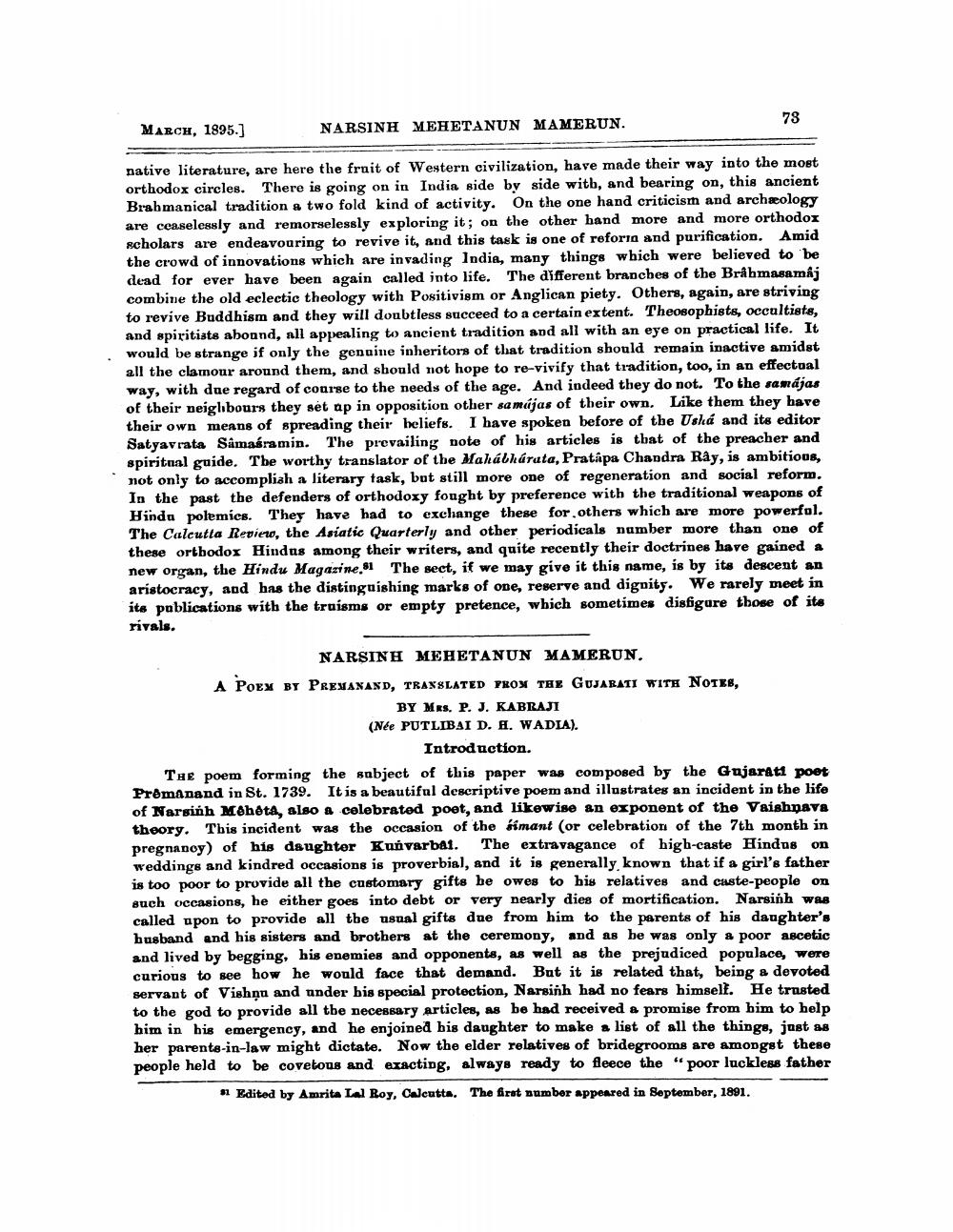________________
MARCH, 1895.)
NARSINH MEHETANUN MAMERUN.
78
native literature, are here the fruit of Western civilization, have made their way into the most orthodox circles. There is going on in India side by side with, and bearing on, this ancient Brahmanical tradition a two fold kind of activity. On the one hand criticism and archæology are ceaselessly and remorselessly exploring it; on the other hand more and more orthodox scholars are endeavouring to revive it, and this task is one of reforia and purification. Amid the crowd of innovations which are invading India, many things which were believed to be dead for ever have been again called into life. The different branches of the Brahmasamaj combine the old eclectic theology with Positivism or Anglican piety. Others, again, are striving to revive Buddhism and they will doubtless succeed to a certain extent. Theosophists, occultists, and spiritists abound, all appealing to ancient tradition and all with an eye on practical life. It would be strange if only the genuine inheritors of that tradition should remain inactive amidst all the clamour around them, and should not hope to re-vivify that tradition, too, in an effectual way, with due regard of course to the needs of the age. And indeed they do not. To the samájas of their neighbours they set ap in opposition other sa májas of their own, Like them they have their own means of spreading their beliefs. I have spoken before of the Ushá and its editor Satyavrata Samaíramin. The prevailing note of his articles is that of the preacher and spiritual guide. The worthy translator of the Mahálkúrata, Pratápa Chandra Rây, is ambitious, not only to accomplish a literary task, but still more one of regeneration and social reform. In the past the defenders of orthodoxy fought by preference with the traditional weapons of Hinda polemics. They have had to exchange these for others which are more powerful. The Calcutta Reviero, the Asiatic Quarterly and other periodicals number more than one of these ortbodox Hindas among their writers, and quite recently their doctrines have gained a new organ, the Hindu Magazine.81 The sect, if we may give it this name, is by its descent an aristocracy, and has the distinguishing marks of one, reserve and dignity. We rarely meet in its publications with the truisms or empty pretence, which sometimes disfigure those of its rivals.
NARSINH MEHETANUN MAMERUN. A POEM BY PREMANAND, TRANSLATED FROM THE GUJARATI WITH NOTEB,
BY MRS. P. J. KABRAJI (Née PUTLIBAI D. A. WADIA).
Introduction. The poem forming the subject of this paper was composed by the Gujarati poet Prêmanand in St. 1739. It is a beautiful descriptive poem and illustrates an incident in the life of Narsińh Mahots, also a celebrated poet, and likewise an exponent of the Vaishnava theory. This incident was the occasion of the simant (or celebration of the 7th month in pregnancy) of his daughtor Kurvarbat. The extravagance of high-caste Hindus on weddings and kindred occasions is proverbial, and it is generally known that if a girl's father is too poor to provide all the customary gifts be owes to his relatives and custe-people on auch occasions, he either goes into debt or very nearly dies of mortification. Narsinh was called upon to provide all the usual gifts due from him to the parents of his daughter's husband and his sisters and brothers at the ceremony, and as he was only a poor ascetic and lived by begging, his enemies and opponents, as well as the prejudiced populace, were curious to see how he would face that demand. But it is related that, being a devoted servant of Vishnu and under bis special protection, Narsinh had no fears himsell. He trusted to the god to provide all the necessary articles, as be had received a promise from him to help him in his emergency, and he enjoined his daughter to make a list of all the things, just as her parents-in-law might dictate. Now the elder relatives of bridegrooms are amongst these people held to be covetous and exacting, always ready to fleece the “poor luckless father
- Edited by Amrita Lal Roy, Calcutta. The first number appeared in September, 1891.




